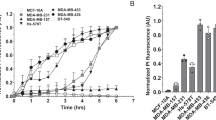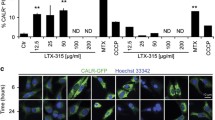Abstract
Purpose
PNC-27, a peptide that contains an HDM-2-binding domain from p53 attached to a membrane-penetrating peptide on its carboxyl terminal end, is cytotoxic to cancer, but not normal, cells. It forms transmembrane pores in the cancer cell membrane. Our purpose is to determine if the whole peptide or critical fragments induce pore formation in cancer cells.
Methods
We have prepared PNC-27 with a green fluorescent label on its amino terminus and a red fluorescent label on its carboxyl terminus and treated MCF-7 breast cancer cells and untransformed MCF-10-2A breast epithelial cells with this double-labeled peptide to determine if combined yellow fluorescence occurs in the membrane of the cancer cells during cancer cell killing.
Results
At 30 min, there is significant combined punctate yellow fluorescence, indicative of intact peptide, in the cell membrane of cancer cells that increases during cancer cell lysis. MCF-10-2A cells show initial (30 min) uniform combined yellow membrane fluorescence that subsequently disappears. Unlike the cancer cells, these untransformed cells remain viable.
Conclusions
PNC-27 induces cancer cell membrane lysis by acting as the whole peptide, not fragments. The punctate yellow fluorescence is due to interaction of PNC-27 with intramembrane targets of MCF-7 cells that do not exist in the membrane of the untransformed cell line. This interaction increases the lifetime of PNC-27. Absence of these targets in the membranes of the untransformed MCF-10-2A cells results in initial uniform fluorescence of the double-labeled peptide in their membranes after which the peptide is degraded.




Similar content being viewed by others
References
Kanovsky M, Raffo A, Drew L, Rosal R, Do T, Friedman FK, Rubinstein P, Visser I, Robinson R, Brandt-Rauf PW, Michl J, Fine RL, Pincus MR (2001) Peptides from the amino terminal mdm-2 binding domain of p53, designed from conformational analysis, are selectively cytotoxic to transformed cells. Proc Nat Acad Sci USA 98:12438–12443
Do TN, Rosal RV, Drew L, Raffo AJ, Michl J, Pincus MR, Friedman FK, Petrylak DP, Cassai N, Szmulewicz J, Sidhu G, Fine RL, Brandt-Rauf PW (2003) Preferential induction of necrosis in human breast cancer cells by a p53 peptide derived from the mdm-2 binding site. Oncogene 22:1431–1444
Pincus MR, Michl J, Bowne WB, Zenilman M (2007) Anti-cancer peptides from the ras-p21 and p53 proteins. In: Mohan RM (ed) Research advances in cancer. Global Research Network Publishers, Kerala, India, pp 65–90
Bowne WB, Sookraj KA, Vishnevetsky M, Adler V, Yazdi E, Lou S, Koenke J, Shteyler V, Ikram K, Harding M, Bluth MH, Ng M, Brandt-Rauf PW, Hannan R, Bradhu S, Zenilman M, Michl J, Pincus MR (2008) The penetratin sequence in the anti-cancer PNC-28 peptide causes tumor necrosis rather than apoptosis of human pancreatic cancer cells. Ann Surg Oncol 15:3588–3600
Michl J, Scharf B, Schmidt A, Hannan R, von Gizycki H, Friedman FK, Brandt-Rauf PW, Fine RL, Pincus MR (2006) PNC-28, a p53 peptide that is cytotoxic to cancer cells, blocks pancreatic cancer cell growth in vivo. Int J Cancer 119:1577–1585
Rosal R, Pincus MR, Brandt-Rauf PW, Fine RL, Michl J, Wang H (2004) NMR solution structure of a peptide from the mdm-2 binding domain of the p53 protein that is selectively cytotoxic to cancer cells. Biochemistry 43:1754–1861
Rosal R, Brandt-Rauf PW, Pincus MR, Wang H, Mao Y, Fine RL (2004) The role of alpha-helical structure in p53 peptides as a determinant for their mechanism of cell death: necrosis versus apoptosis. Adv Drug Devl Rev 57:653–660
Belmokhtar CA, Hillion J, Ségal-Bendirdjian E (2001) Staurosporine induces apoptosis through both caspase-dependent and caspase-independent mechanisms. Oncogene 20:3354–3362
Acknowledgments
This work was supported in part by a Lustgarten Foundation grant for Pancreatic Cancer Research (to MRP and JM) and a VA Grant and an American College of Surgeon’s Faculty Research Fellowship Award to WBB.
Author information
Authors and Affiliations
Corresponding authors
Rights and permissions
About this article
Cite this article
Sookraj, K.A., Bowne, W.B., Adler, V. et al. The anti-cancer peptide, PNC-27, induces tumor cell lysis as the intact peptide. Cancer Chemother Pharmacol 66, 325–331 (2010). https://doi.org/10.1007/s00280-009-1166-7
Received:
Accepted:
Published:
Issue Date:
DOI: https://doi.org/10.1007/s00280-009-1166-7




